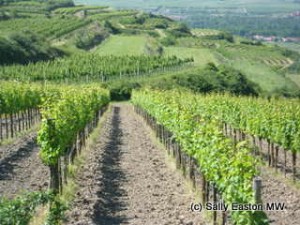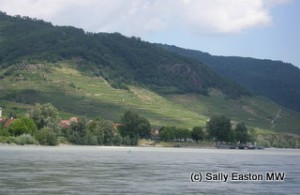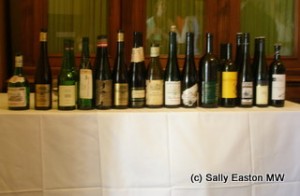Austria’s grüner veltliner ageing gracefully
Austria’s grüner veltliner is a bit of a star grape variety. It’s adaptable and flexible as to style, it’s a great general ‘food wine’, and, having been fortunate enough to taste some old examples, I know it can age extremely well and characterfully.
In a 2002 tasting overseen by Jancis Robinson MW, grüner veltliner notably beat all-comer chardonnays into third place (even that chardonnay was Austrian). The top Burgundy in the event got 18th slot.

Kamptal
As with other high quality white grape varieties such as chardonnay and riesling, grüner veltliner can be made in a range of styles, from light-bodied, simple, quaffing wine, to the seriously concentrated, rich and full-blooded (even for a white wine). The latter invariably have a degree or two more alcohol than the former.
Alcohol is a preservative, so this may have some part to play in bottle longevity. Though some long-lived German rieslings have less than 10% alcohol (but perhaps compensate with alternative preservative, residual sugar.)
New oak rarely features with grüner veltliner. Though its tannins might provide some preserving influence, the dominant flavour of new oak is evidently thought to be too much for the relatively aromatic grüner veltliner variety.
Pre-fermentation skin maceration is another point of discussion and Willi Bründlmayer, of his eponymous estate in Kamptal, suggested the extraction of too many phenolics might detract from longevity in bottle. He said: “I prefer whole bunch pressing with ripe grüner veltliner. I don’t like overloaded wines but ones with discreet, subdued personality and elegance. Oak fermentation is possible but not necessary for great grüner veltliner; personally I like larger acacia casks which are good for maturing on fine lees.”
As with riesling, the malo-lactic fermentation is usually blocked on grüner veltliner. During a tasting of aged grüner veltliners on an Institute of Masters of Wine (IMW) trip to Austria in 2002, Michi Moosbrugger of Schloss Gobelsburg, also in Kamptal, said “we tried a small proportion of malo in 1997, an excellent vintage with early flowering and a long summer, to see, but we didn’t like the results for several years.” Five years later they liked it more, but Moosbrugger added, you “lose very many elements that are seen as typical aspects of grüner veltliner – the varietal character changes and it goes to an international style.”

Steep Wachau slopes
A further issue for longevity is whether to use a proportion of fruit affected with ‘good botrytis’, as in noble rot, rather than the rotting-to-mouldy-mush grey botrytis which results from too much damp and rain as berries are nearing ripeness. Bründlmayer said during the 2002 IMW tasting he believed “grüner veltliner with botrytis does not age so well. It makes the evolution of the wine dangerous” without expanding on how, but a certain type of rusticity is said to evolve.
Sepp Mantler of Mantlerhof in Kremstal agreed with the point about botrytis, adding they were “showing wines from one vineyard (Spiegel), from years with no botrytis, and only good years.”
Today, both a lighter style (lighter bodied, lighter in alcohol – 11-12%) and a denser, richer style (more body, more vinosity, more alcohol – 13.5-14.5%) of grüner veltliner are made, as well as in-between styles. At the 2002 IMW tasting, it was noticed that several of the older wines, from the 1960s and 1970s, were made in the lighter style, picking early to avoid high phenolics and high alcohol, which also meant acidities were a bit higher. The more recent style is for later harvest, greater ripeness with the concomitant higher alcohol and lower acidity.
Some of these lighter-styled grüner veltliners showed really well. The 1979 grüner veltliner from Lenz Moser, (2002 tasting) with 11.8% alcohol, had taken on toast, brioche and lanolin characters that might equally have described an aged Australian Semillon or an aged white Burgundy. It was well balanced with a silky texture and an elegance without power, which would concord with the alcohol level.
Similarly, Salomon’s 1987 grüner veltliner Undhof Wieden (2002 tasting) was still showing attractive tightness and linearity of structure, with great youth of citrus and white pepper spiciness. All this with just 12% alcohol.
Gobelsburg’s 1987 grüner veltliner ‘Cabinet’ (2002 tasting) in the lighter style – 11.8% alcohol – still showed amazing freshness for a lighter style; it had developed the by now familiar toasty nose, but was also taking on a faint savoury and slightly metallic character. Perhaps a limit of ageing for the lighter styles exists.
These two 1987s showed well despite it being a late vintage of average quality, lying in the shadow of both 1985 and 1986.
Schloss Gobelsburg’s 1967 grüner veltliner from the slopes of Gaisberg, (2002 tasting), with 12.4%, was a remarkable wine, both delicious and elegant, though these two are obviously not mutually exclusive. Dense fruit, with tobacco and dry, honeyed, toast notes created a lovely balance with some fresh biscuity flavours coming through.
Generally though, it was the richer, more unctuous styles, still perceptively dry, that came into their own with some age, at both the IMW tasting, and at the Austrian Wine Summit during 2009, where international specialists in the wine sector are invited on detailed tours by the Austrian Wine Marketing organisation.
Mantlerhof’s Spiegel grüner veltliner from 1977, (2002 tasting) with a hint of residual sugar in its richer style was a honeyed, rich, dense wine, but still supple, with a silky texture, luscious-yet-dry tropical and yellow fruits. The deep golden colour belied its youth, and indeed colour of wine proved to be no predictor of age or potential.
Bründlmayer’s Loiser Berg from 1975 (2002 tasting) was remarkably fresh, with just 11.5%, honeyed and silky, and very nicely balanced. His 1969 Kirchengarten, with 13.5% was toasty, with lanolin notes, rich, dense, sweet fruit and beautiful balance, density and concentration, combining elegance and power with subtlety and harmony.

Aged grüner veltliner tasting line up
In the 2009 tasting, Bründlmayer’s grüner veltliner Lamm 1995, also showed prowess, with a steely, cream and lemon toast on the nose and attack. Non-fruity notes were developing on the medium-bodied palate. The intensity and still-freshening acidity gave the wine a refined and powerful demeanour. A wine of elegance, structure and refinement. For his ageing goals on grüner veltliner, Bründlmayer said: “there is no single component to be responsible for ‘matureability’ but a rich character without predominance of acidity, tannins, alcohol or whatever, and enough ‘hidden potential’ to make a maturing process worthwhile.”
The Alzinger grüner veltliner Reserve 2001, from eastern Wachau, was another star from the 2009 tasting. The Reserve is a blend of more than one vineyard. The wine showed no real evidence of any age, and its 14.5% alcohol was perfectly integrated. Aromas and flavours were of apple, baked, citrus, dry honey and steel. A creamy hint was developing on the palate, which had a lovely balance, both intense and concentrated, with a finish to linger over.
Another wine showing no signs of age was Proidl’s grüner veltliner Ehrenfels 1999, from Kremstal. A lemon yellow colour gave was to citrus and intense yellow fruits exploding on the mid-palate. This was a very youthful wine still with its primary fruit spectrum, and showing an amazing freshness and length.
Nikolaihof’s grüner veltliner Vinothek 1991, from Wachau deserves special mention. These guys are pretty unique. This wine was aged in big old casks for 15 years, only being bottled in 2006, so this is something of a cask-aged/bottle-aged hybrid, and completely delightful for that. They’re also biodynamic. The wine had notes of steel, honeysuckle, and something almost petrol-like. It showed baked lemon on the reasonably light bodied palate (just 12.5% in this wine), along with a linearity rather than explosive mid-palate. Still no real signs of ageing, but an elegant, subtle wine, that lingered almost in the imagination.
These sorts of tastings throw up far more questions than they can ever answer. But it is a privilege to be involved with them, and it’s a great intellectual and hedonistic pursuit. Not least because it’s estimated that 95% of grüner veltliner is drunk within three years of the harvest.
Ten to fifteen years seems like a reasonable band for the ageing of the best of these wines, which is probably as much as you’d expect for most white wines, though there were one or two extraordinary examples of note that were older than this.
Comments
One Response to “Austria’s grüner veltliner ageing gracefully”




August 25, 2009 at 2:17 pm
Great piece on Austrian wines. I went to Austria in June for the Austrian Wine Marketing Board’s annual wine summit. I’m currently working on a social media marketing/e-commerce project for the AWMB. Your post brought back many memories of the trip, the sights, and of course the wines.